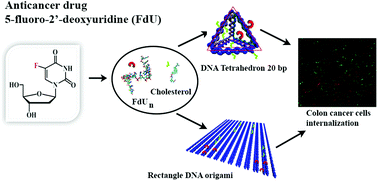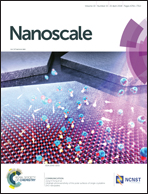DNA-based nanoscaffolds as vehicles for 5-fluoro-2′-deoxyuridine oligomers in colorectal cancer therapy†
Abstract
Fluoropyrimidines, such as 5-fluorouracil (5-FU) and related prodrugs, are considered one of the most successful agents in the treatment of colorectal cancer, yet poor specificity and tumor cell resistance remain the major limiting bottlenecks. Here, we exploited for the first time the ability of two DNA nanoscaffolds, a DNA tetrahedron (Td) and rectangle DNA origami, to incorporate 5-fluoro-2′-deoxyuridine (FdUn) oligomers. In addition, cholesterol moieties were synthetically attached to Td and DNA origami staples to enhance cellular uptake. DNA nanostructures functionalized with FdUn exhibited an enhanced cytotoxicity and higher ability to trigger apoptosis in colorectal cancer cells relative to conventional 5-FU and FdU, especially having cholesterol as an internalization helper. The cholesterol content mostly correlates with the increase of the FdUn nanostructure cytotoxicity. DNA nanoscaffolds bearing FdUn were able to circumvent the low sensitivity of colorectal cancer cells towards 5-FU. Both DNA nanostructures attained a comparable cytotoxic effect yet Td displays higher antiproliferative action. The ability to reduce the proliferation of cancer cells is mainly related to the concentration of DNA nanostructures. The present work suggests that self-assembled DNA nanoparticles are privileged vehicles for delivering fluoropyrimidines, opening new avenues to the development of promising therapeutics for cancer treatment.



 Please wait while we load your content...
Please wait while we load your content...